If you are an electronics enthusiast or a maker, then you probably need an adjustable DC power supply for you workbench. So in this article we will review the LONG WEI PS-3010DF DC power supply.
The LONG WEI PS-3010DF provides regulated DC output in range from 0 to 30V at 0 to 10A. We can easily adjust the voltage and the current with the two knobs for each unit, one for course and one for fine adjustment. A good feature is that we can set a constant current independently of the voltage. This is very useful for over-current protection in our circuit.
It has three LED displays with four digits, which shows the voltage, the current and the power. The power output display can be quite handy in many situations. As this is a multi-purpose power supply it has another cool feature, and that’s an USB interface which provides 5V at 2A output.

Get it from Banggood
Disclosure: These is an affiliate link. This means at no cost to you, I receive a small commission if you purchase through my link.
Before unboxing it and conducting some tests, let’s take a look at the technical parameters of the LONG WEI PS-3010DF DC power supply.
Technical parameters:
- Input voltage: 110V/220V ±10% @ 60Hz/50Hz
- Output voltage: 0 – 30V continuously adjustable
- Output current: 0 – 10A continuously adjustable
- Display: 4-digit LED display with accuracy of ±0.1% ± 1 word
- Power supply effect: CV≤0.1%+10mV CC≤0.1%+10mA
- Load effect: CV≤0.1%+5mV CC≤0.1%+10mV
- Ripple and noise: CV≤10mV r.m.s. CC≤20mA r.m.s.
- Machine efficiency: ≥80% (tested under full load)
- Working environment: -10 °C – +40 °C Relative humidity 20% -80%
Unboxing
The power supply comes well packed with foam cushions, keeping it safe during the shipping.
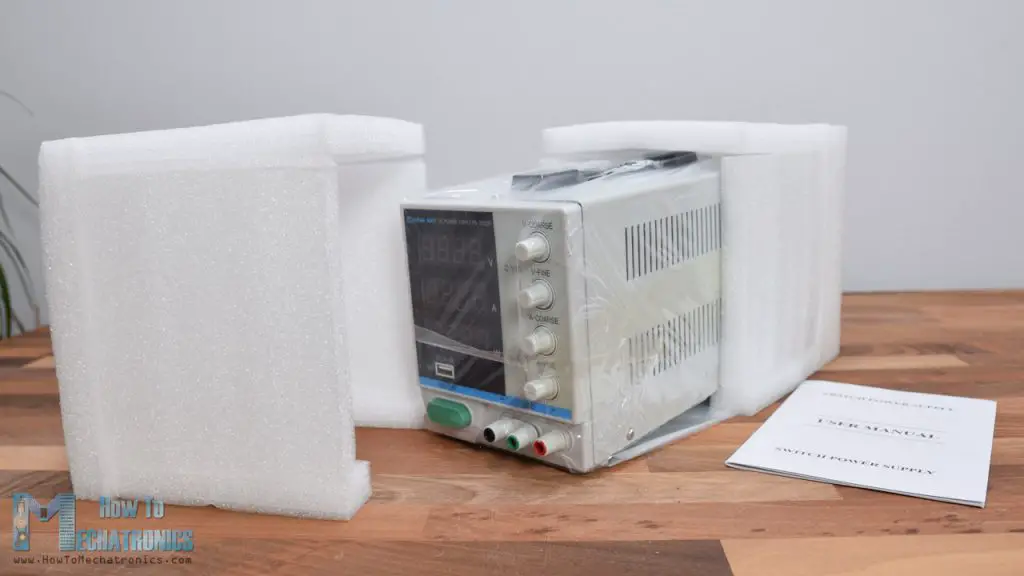
The package contains a manual, a power cord and an power plug adapter.

We should note that it does not come with accessories like banana or alligator clips. You will have to make or buy them separately.
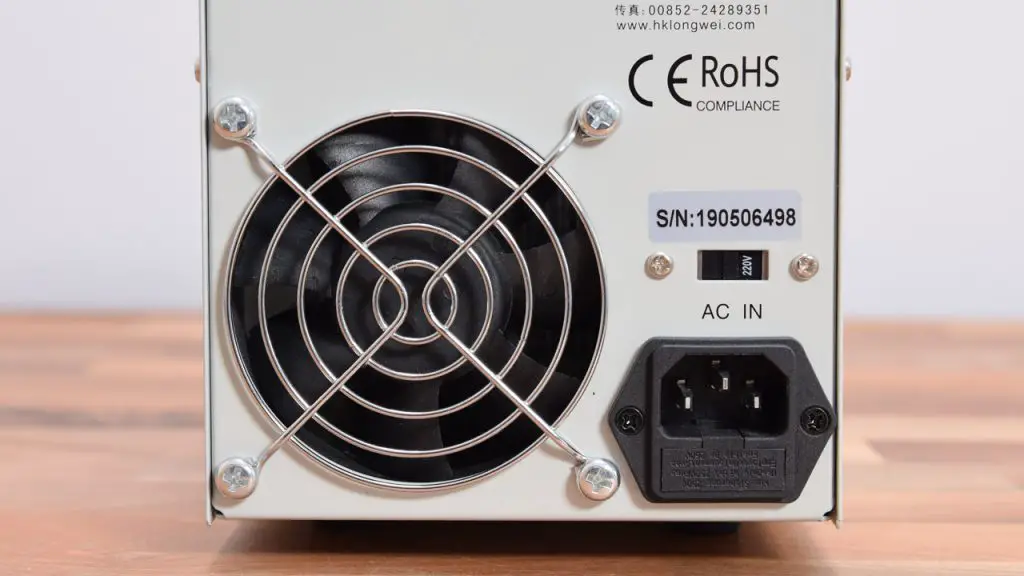
On the back side of the power supply, we can select the AC input voltage, 110V or 220V. Here we also have the fan for cooling the power supply. The fan starts at power up, but it turns off right away. It stays off until a the power supply reach a particular temperature.
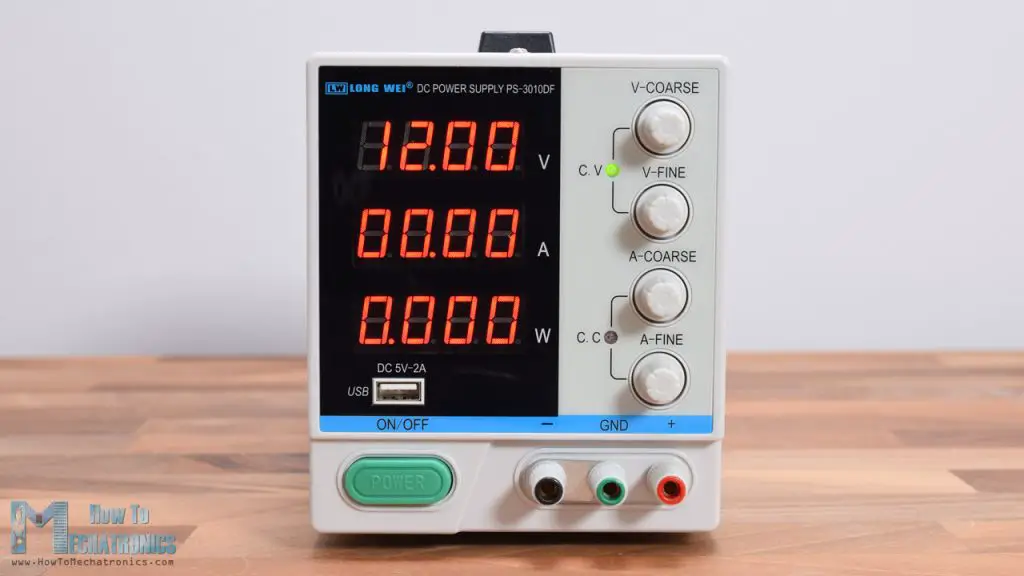
On the front side we have the nice and bright three rows of 4-digit displays, showing voltage, the current and the power. On the right side there are four knobs, for coarse and fine adjustment of the voltage and the current. Right next to them, there are LEDs for indicating whether we are in Constant Voltage or Constant Current mode.
The power button is on the bottom left side, and on the right side we have the outputs connections. Additionally there is an USB interface which provide 5V at 2A.
Testing the DC power supply
All right, so now let’s make several tests to see how this power supply performs and how it works.
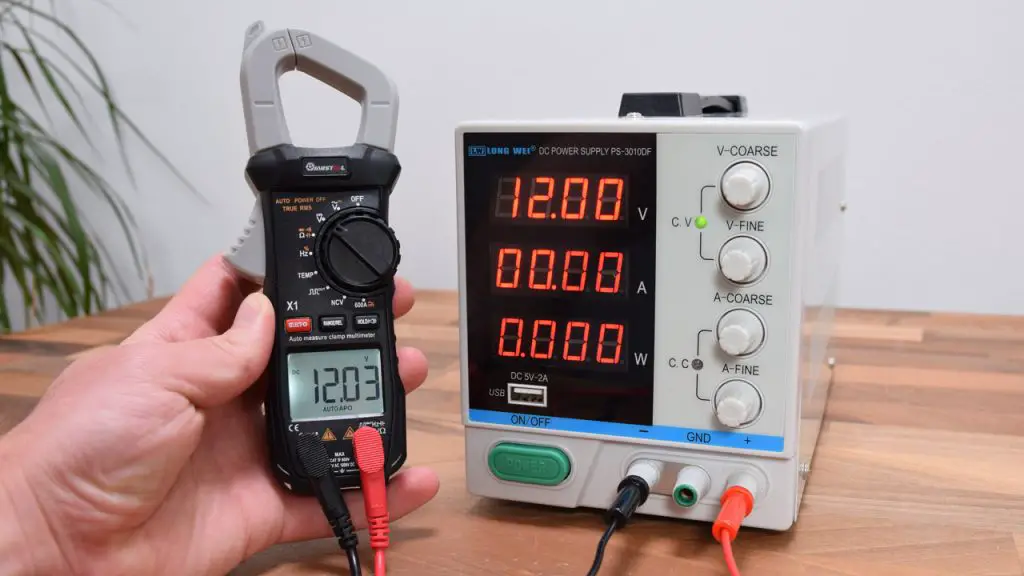
The first test is checking the output voltage using a multimeter. I set the power supply to 12V and I got a 12.03V read out on my Mustool clamp multimeter. That’s quite close but to be honest I don’t whether is multimeter itself is that much accurate, but still that’s a good result. Here we can see that the C.V LED is light up, which means we are in constant voltage mode. No matter what we will attach to the probes the voltage won’t go above 12V.
For current limiting, or setting a constant current we can connect the two probes together. The power supply can limit the current from 0 to 10A.

It’s worth noting that for we need at least 18-gauge wire when dealing with 10A of current. So make sure you have the proper probes for the job. The probes I had were already getting like really at around 6A of current, so I didn’t how any further.
Nevertheless, I set the current limit to 1A for the following example. Also I set the voltage to 10V and connected a 10 ohms resistor to the probes.
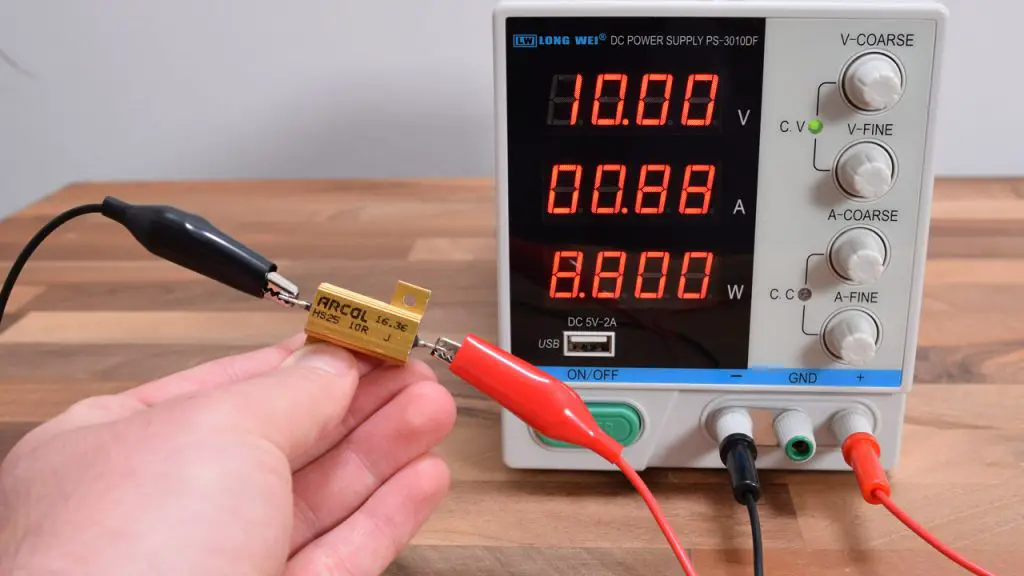
Theoretically, at 10V and 10 ohms resistor, 1A of current should flow through the resistor, I = V / R (Ohm’s Law). However, that’s in ideal conditions and at constant temperature. What I got here was 0.88A of current flow through the resistor.
I connected a second resistor in series with the same specs 10 ohms, 25W. Now we have double the resistance so the current should be half the previous.
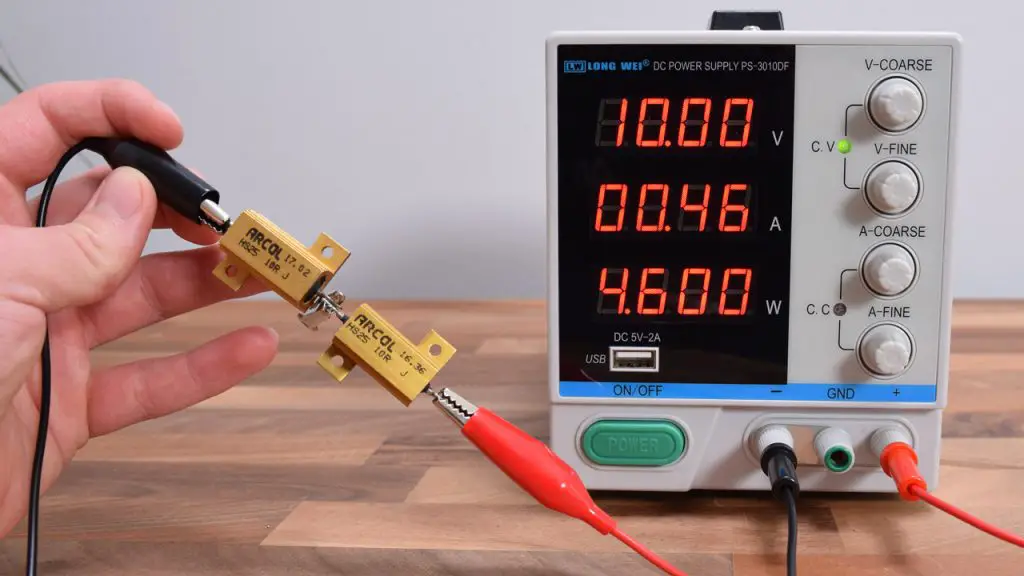
Again, not exactly like in theory, but close enough, 0.46A flow through 20 ohms resistance.
Now let’s see what will happen if we connect these two resistors in parallel connection. Theoretically, we should get double current flow. In parallel connection the same amount of current will flow through both resistors, so 0.88 * 2 should be around 1.76A of total current flow through the probes.

So, once we connected them, the current limiting feature got activated. As we set the constant current to 1A earlier, although this setup would have drawn around 1.7A at 10V, the current limiting feature automatically dropped the voltage so that current stays at 1A. This feature is so useful when testing electronic components or devices, because we can avoid high current flows and prevent burning them.
At this situation, even if we move the voltage dials we voltage won’t increase. We need to move the current dial and increase the current limit until we mach the 10V that we want. Now we got a 1.49A of current flow, which again is not the same as in theory.

We can note that once we reach the 10V that were previously set, the constant voltage LED will light up. Now even if we increase the current dials we won’t increase the current flow because the voltage is fixed at 10V.
Nevertheless, I tested few more devices with the power supply. This is a 9V to 14V DC motor air pump. At 13.75V it draw 0.37A.
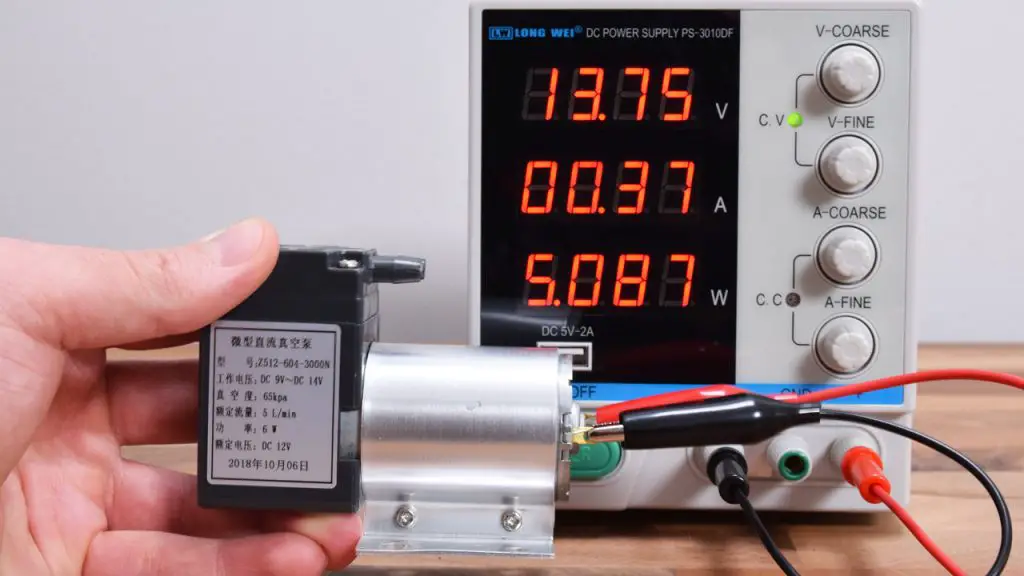
Here’s another test with 12V fan. The fan rating is 0.06A, and that’s exactly what we got from the power supply.
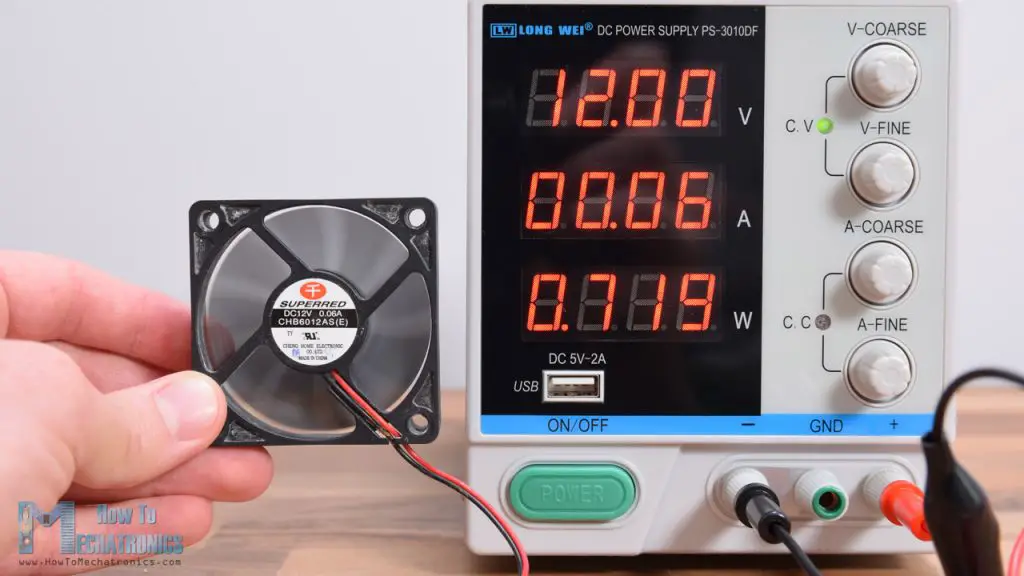
The USB interface can be pretty handy sometimes. Here I’m charging my phone with it.

Conclusion
So overall, the LONG WEI PS-3010DF is a good power supply for electronics hobbyists and makers. All these features, the 4-digit displays, the coarse and fine adjustment, the current limiting, the USB interface, as well as the build quality we are getting with this adjustable DC power supply are quite great for its price point.
You can get the LONG WEI PS-3010DF from Banggood, which were kind enough to send me a free example of dc power supply so I can test it and make this review.
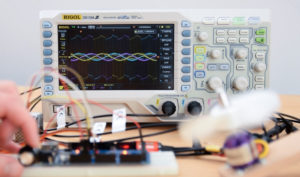
Great website. Funny, cause I have the same PS and ampclamp as you have. They both have a different name on them, I bought mine from Amazon vs BG. No suprise.
I bought the PS for testing high power laser diodes harvested out of videoprojectors. I had a 0-30v 5A linear variable PS before this but diode tech has progressed to where I needed more than 5A, this was basically the least expensive at the time for 10A. One has to be careful with this supply as the course adjustments are VERY touchy, especially the current knob. The potentiometer is fine, it seems proportional, no glitches, but still a little movement can equal a large jump in current or to a lesser degree voltage. I smoked several very expensive diodes because of this. I have to mention that my old PS had course and fine reversed from this one so my muscle memory contributed to my screw-ups as well but still, my old PS wasn’t as “touchy”.
The clamp meter seems accurate enough compared against several other older meters made by Fluke. They are the Fluke 87V5 and a 79 series. I also have Flukes 400A AC/DC current clamp that has no display of its own, you convert mV by connecting to a multimeter. I did take it apart(the mustool /generic ampclamp) to see what makes it tic and its doesn’t exactly inspire confidence. Im fine with using it on 120VAC or below something like 75V DC but I would be far more caution if I brought it to work(Im an electrician) and measured voltage between phases of a 277/480V three-phase installation.
Thanks for the input!